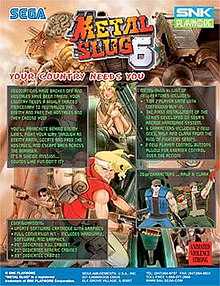
Shoot 'em ups are a sub-genre of action games. There is no consensus as to which design elements compose a shoot 'em up; some restrict the definition to games featuring spacecraft and certain types of character movement, while others allow a broader definition including characters on foot and a variety of perspectives.

Metal Slug is a 1996 run and gun arcade video game originally developed by Nazca Corporation and released by SNK for the Neo Geo MVS. It is the first installment in the eponymous series. Set in 2028, players assume the role of Peregrine Falcon Strike Force soldiers Marco Rossi and Tarma Roving on a fight against the Rebel Army led by Donald Morden and overthrow his coup d'état to prevent a New World Order.

Shooter video games or shooters are a subgenre of action video games where the focus is almost entirely on the defeat of the character's enemies using the weapons given to the player. Usually these weapons are firearms or some other long-range weapons, and can be used in combination with other tools such as grenades for indirect offense, armor for additional defense, or accessories such as telescopic sights to modify the behavior of the weapons. A common resource found in many shooter games is ammunition, armor or health, or upgrades which augment the player character's weapons.

The Atomiswave is a custom arcade system board and cabinet from Sammy Corporation. It is based on Sega's Dreamcast console, sharing similarities with the NAOMI, as far as it uses interchangeable game cartridges, as well as a removable module for changing the control scheme, but unlike the NAOMI, the Atomiswave does not feature expanded RAM compared to the Dreamcast.
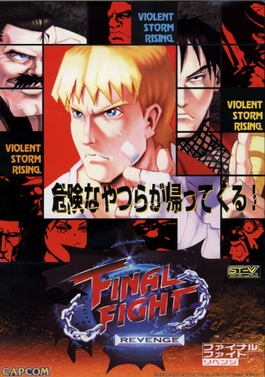
Final Fight Revenge is a 1999 3D fighting game released by Capcom. Revenge is the only one-on-one fighting game in the Final Fight series of games. The cast of playable characters includes series mainstays Mike Haggar, Cody and Guy, along with various members of the opposing Mad Gear gang. Originally developed for the Sega Saturn-based ST-V arcade hardware, a home version of Revenge for the Saturn only in Japan followed in 2000. A Dreamcast version was planned, but it was cancelled.
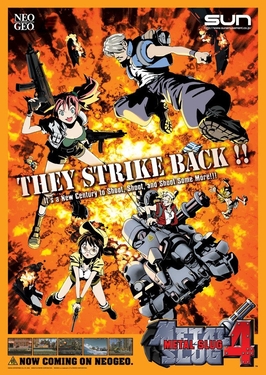
Metal Slug 4 is a run and gun video game for the Neo-Geo console/arcade platform created by Mega Enterprise along with Noise Factory. It was released in 2002 for the Neo-Geo MVS arcade platform, and is the fourth game in the Metal Slug series. Two years later, Playmore published Metal Slug 4 for consoles.

Zombie Revenge is a beat 'em up video game released for arcades and Dreamcast in 1999. Armed with their fists, feet, and whatever weapons they should find along the way, players are tasked with ridding an unnamed city of zombies. Originally titled Blood Bullet: The House of the Dead Side Story, the game was renamed Zombies Nightmare before Sega decided on the name Zombie Revenge.

Metal Slug is a Japanese multimedia franchise and run and gun video game series originally created by Nazca Corporation before merging with SNK in 1996 after the completion of the first game in the series. Spin-off games include a third-person shooter to commemorate the 10th anniversary of the series and a tower defense game for the mobile platform. Originally created for Neo-Geo arcade machines hardware (MVS) and the Neo-Geo home game consoles (AES) hardware, the original games have also been ported to other consoles and mobile platforms throughout the years, with several later games created for various other platforms. The games focus on the Peregrine Falcon Squad, a small group of soldiers who fight against a rebel army, aliens, zombies, mummies and various other forces intent on world domination.

Metal Slug 2 is a run and gun video game developed by SNK. It was originally released in 1998 for the Neo-Geo MVS arcade platform as the sequel to the 1996 game Metal Slug. The original version of the game had extensive slowdown and performance issues, eventually leading SNK to release a modified version in 1999 titled Metal Slug X: Super Vehicle-001 (メタルスラッグX). It has been ported to the Neo Geo CD, PlayStation, Virtual Console, iOS and Android, and to the Wii, PlayStation Portable and PlayStation 2. The game added several new features to the gameplay of the original Metal Slug, such as new weapons, vehicles and the ability to transform the character. It received generally positive reviews. It was followed by Metal Slug 3 released in 2000.

Metal Slug 3 is a run and gun video game developed by SNK. It was originally released in 2000 for the Neo-Geo MVS arcade platform as the sequel to Metal Slug 2/Metal Slug X. The music of the game was developed by Noise Factory.
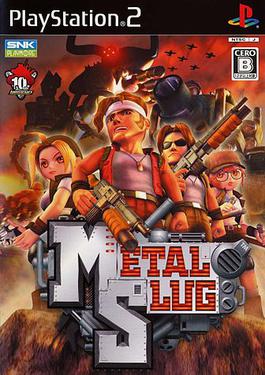
Metal Slug, also called Metal Slug 3D (メタルスラッグ3D) to distinguish it from the original Metal Slug, is a third-person shooter run and gun video game for the PlayStation 2. It was developed and published by SNK Playmore.

Metal Slug 5 is a run and gun video game for the Neo-Geo created by SNK Playmore. It was released in 2003 for the MVS arcade platform and is the fifth game in the Metal Slug series. The game was developed by Noise Factory/SNK Playmore, after Korean company Mega Enterprise had directed Metal Slug 4. It was the last Metal Slug released on the Neo Geo.
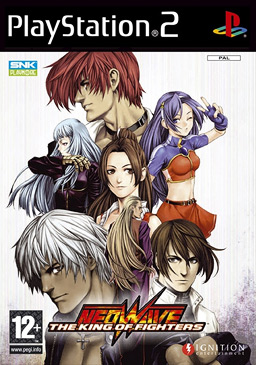
The King of Fighters Neowave(KOF Neowave, or KOF NW) is a 2D fighting game produced by SNK Playmore and released as a coin-operated arcade game for Sammy's Atomiswave hardware in 2004. It was the first game SNK Playmore produced for the Atomiswave. This is a remake of The King of Fighters 2002 with a major change of roster and stages, the game was also made on the PlayStation 2 and Xbox. The PS2 version was released only in Japan and the PAL region, the Xbox version was released both in Japan and North America. The North American version was released on April 18, 2006. In 2020, a Dreamcast homebrew adaptation of the arcade version was also made possible due to the Dreamcast sharing almost identical hardware with its Atomiswave cousin. The character artwork was done by Tomokazu Nakano. In Japan, it was the last game to be released for the Xbox.

Samurai Shodown VI, known as Samurai Spirits: Tale of the World's Greatest Swordsman in Japan, is the tenth iteration in the Samurai Shodown series.

Neo Geo Battle Coliseum, abbreviated NGBC or NBC, is a 2-on-2 tag team fighting game designed for the Atomiswave arcade board developed and released by SNK in 2005. The game features characters from several SNK and ADK titles. Subsequently, a PlayStation 2 version of the game was released in Japan, North America, and Europe. The Xbox Live Arcade version was released worldwide on June 9, 2010. In 2020, a homebrew conversion was released for the Dreamcast.

Mars Matrix: Hyper Solid Shooting, or simply Mars Matrix, is a vertically scrolling shooter arcade game developed by Takumi and released in 2000. The game was published by Capcom and run on their CPS-2 arcade system board. Mars Matrix was later ported to the Dreamcast video game console in 2001. The arcade version uses a horizontally aligned monitor, despite being a vertically scrolling game.

Metal Slug 7 is a run and gun video game developed by SNK Playmore for the Nintendo DS. It is the seventh and final title in the main Metal Slug series. It marks the first game in the main series that would be released without an arcade version. The game was released in 2008 for Japan on July 22 and North America on November 28 by Ignition Entertainment.

Resident Evil Survivor 2 – Code: Veronica is a video game developed and published by Capcom as part of the Resident Evil series. The arcade version was developed in conjunction with Namco for the arcade machines. The game was released for Sega NAOMI and PlayStation 2. It was released on the PlayStation 2 on November 8, 2001 in Japan and in Europe on March 22, 2002. Whilst the Playstation 2 release is a light gun shooter, the NAOMI arcade release features no lightgun technology whatsoever, instead deferring control of each player entirely to a three-axis joystick in the shape of a gun. The game is the second instalment in the Gun Survivor series and the sequel to Resident Evil Survivor. The game is adapted from Resident Evil – Code: Veronica and features enemies and characters from that game, and enemies from Resident Evil 2 and 3. It was followed by Dino Stalker which is a spin-off of Dino Crisis, and has no ties to Resident Evil.
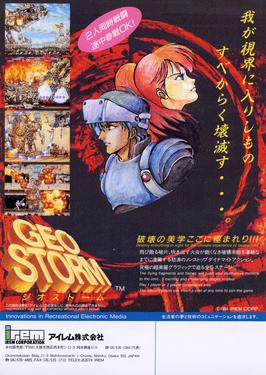
GunForce II is a run and gun arcade video game developed and originally published by Irem on September 1994. It is the sequel to the original GunForce and one of the last arcade games, if not the last to be released by the company before ceasing development of video games in the same year, after which a group of employees from the gaming division of Irem would go on to form Nazca Corporation due to being tired of the company's inactivity.

Blazing Chrome is a run and gun video game developed by JoyMasher and published by The Arcade Crew. The game was released on July 11, 2019 for Windows, Nintendo Switch, PlayStation 4, and Xbox One, and on November 19, 2020 for Amazon Luna. The game is set in the post-apocalyptic future of 21XX, following a war that nearly kills off the human race. A robot army rules the world, and attempt to destroy the remnants of humanity. The game follows a resistance group who fights back against them. Players can control two different characters: Mavra, a human resistance soldier, and Doyle, a robot reprogrammed to fight for the resistance.
